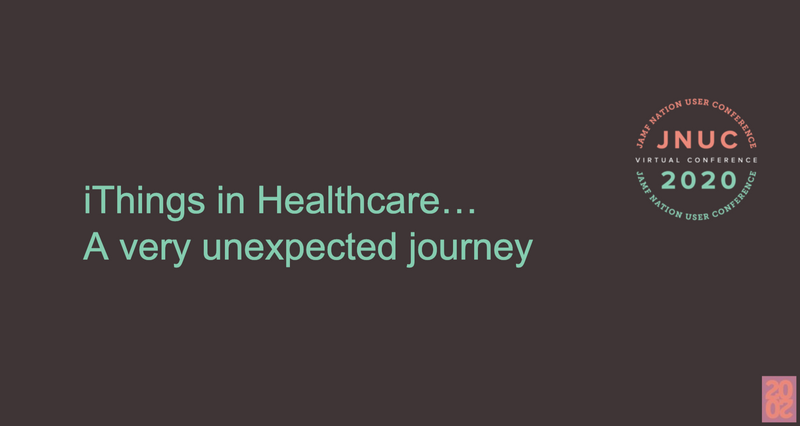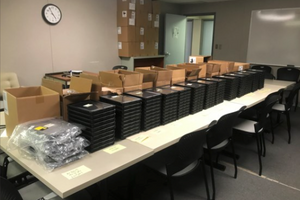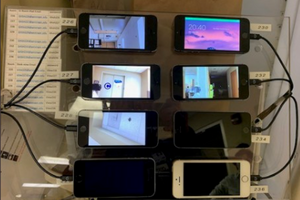The evolution of mobile devices and healthcare-focused apps over the past decade paved the way for the exponential growth of their usage in healthcare. Keeping up with advancing technology typically means new opportunities for productivity and better user experience, but it only occurs successfully with the right implementation.
For years now, the IT team at Geisinger Health System in Pennsylvania has navigated a complex journey to find creative solutions for new opportunities that advancing technology offers.
At JNUC 2020, James Rafel, Program Director on the Geisinger team, took to the virtual stage to walk through projects along this journey and explain how they’ve been able to adapt and improve across 3 key areas: patient experience, clinical communications and, most recently, telehealth.
Apple and iOS in Healthcare
Geisinger is a large health system, with over 32,000 employees across 13 campuses. It is mostly a Windows shop, but many years ago, James and his team set out to increase its Apple device presence, due to their popularity with end users. Today, the majority of its 11,000+ mobile device fleet are iPad and iPhone.
The Geisinger team started out in 2008 by enabling their clinical teams with iPhones, primarily to access email. The next big initiative was an iPad app for staff in 2011, followed soon after by utilizing iPads for patient surveys in 2013.
In 2014, however, a real ‘paradigm shift’ occurred; they found Jamf.
As James described it, mobile device management (MDM) is the magic — the people behind it (IT, Operations and Information Security teams) are the magicians. James knew that this technology, when paired with the careful implementation and the proper workflows, could be used to radically improve the way the hospital worked, for both patients and providers.
So, what came next?
The Interactive Patient System (IPS)
After extensive meetings and planning, the Geisinger team had what they called the Interactive Patient System (IPS). This system would aim to keep patients engaged, informed, connected and entertained throughout the care process, all while maintaining data security, infection control procedure and clinical staff buy-in. A pretty impressive goal, but what powered it?
- Apple Business Manager - Apple’s deployment program allowed flexibility when licensing and distributing apps
- Jamf Setup and Jamf Reset - iOS apps that streamline device sharing for any use case, no cart or IT required
- Jamf’s Healthcare Listener - An EMR integration to automate the management of patient bedside devices
V1: The first version of the IPS utilized monolithic imaging, didn’t have automatic device enrollment (formerly DEP), and devices had to be manually reloaded. Nurses would take an iPad from a patient room to a backroom, plug it into a Mac mini, wait 30 minutes while it updated and return it to the patient room. While this was slow, it was the best they had at the time.
V2: The next iteration of the IPS was a vast improvement — dynamic imaging, automatic device enrollment and caching all improved the experience by shortening the 30-minute wait to roughly 2 minutes. However, the staff workflow remained mostly unchanged, which wasn’t ideal for nurses.
V3: James credits Jamf’s Healthcare Listener, with the ability to automate the reload of patient bedside devices, with being the real game-changer. Now, nurses didn’t have to take the iPads anywhere; IT could manage them remotely with smart groups and configuration profiles. Plus, with this new workflow, Mac minis in a separate room were no longer needed.
Automate, then innovate
With a system in place that automates tasks for both clinical staff and IT, James’ team had time to explore and implement other innovative ideas, such as:
- Classroom Connect - Hospitalized children could use their bedside iPads, with video conferencing tools, to connect to their school classrooms in a privacy-protected manner. After working with schools in the area, the project allowed students to keep up with classroom work and reduce social isolation.
- Interpretive Services - In 2016, James’ team was tasked with supporting interpretive services for patients via technology, as part of the Affordable Care Act. They ultimately had to use single-purpose, non-Apple device to support this. The lack of automated management features had James missing Jamf.
- BYOD iPhone - In a collaboration between IT and operational staff, a Bring Your Own Device program was launched, which meant that James’ team had to procure a number of HIPAA-compliant tools to enable clinical staff. Using Jamf, they deployed TigerConnect (secure text messaging to communicate about patient care), Haiku/Canto (EMR access on a mobile device), Rover (flow sheet documentation) and other reference apps.
New solutions since COVID
A few days before the COVID-19 outbreak began to make news in the US, James was giving a presentation about IT in healthcare. When reflecting back on this moment, James observed how well-positioned they were for the massive change that was about to take place.
Thanks to Jamf Pro features like Extension Attributes, Smart Device Groups, Configuration Profiles and many more, he was ready to provision more than 1,000 iPads for providers in need amid high and critical stakes. In those hectic weeks, his team also:
- Created 8 new inpatient/outpatient configurations that Geisinger would continue to use moving forward
- Drop-shipped pre-configured iPads to all campuses
- Put together the Because We Care program, which provided isolated patients and their families a means to connect in end-of-life situations
After the initial rush, James’ team has since been focused on setting up telehealth sessions as quickly as possible, along with training for all of their providers. They’ve deployed the Geisinger telehealth app to patient bedside iPads and configured provider devices to allow clinical staff to take iPads home.
They’ve also gotten extremely creative in these unprecedented times. One such solution is how they used decommissioned iPhones to create a grid of cameras to monitor patients at the bedside remotely. Together with the nurses on staff, they also created a cheat sheet of different iPad wallpapers that explain the purpose of the device.
What’s next for IT in Healthcare?
The Geisinger IT team is in a great place, but James is already preparing for the future. He and his team are busy scaling and optimizing their telehealth solution for continued and future use, as well as preparing for additional waves of COVID.
As more resources become available, he will be setting his sights on tighter integrations with clinical peripherals and EHRs, enabling practitioner mobility and app transitions.
Through creative thinking, close collaboration with clinical staff and the right technology solutions, Geisinger is a shining example of how innovation in healthcare can improve patient experience, make clinical communications more effective and pave the way for a new method of care from anywhere.
To learn more about Geisinger's experience and plan for the future of healthcare, view this session on-demand.
Learn more about Virtual Visits:
Get started today with a free trial:
by Category:
Have market trends, Apple updates and Jamf news delivered directly to your inbox.
To learn more about how we collect, use, disclose, transfer, and store your information, please visit our Privacy Policy.





